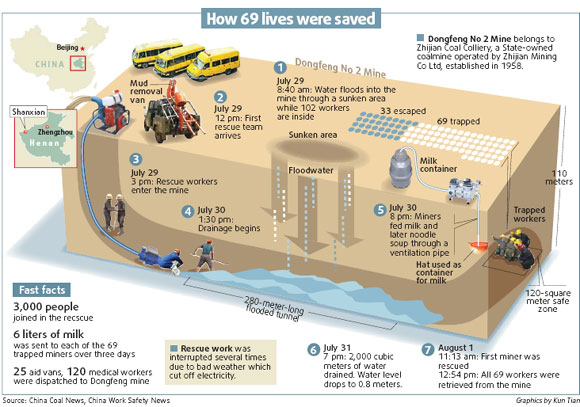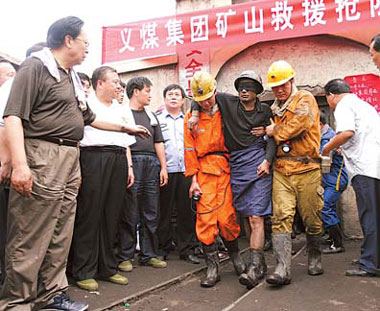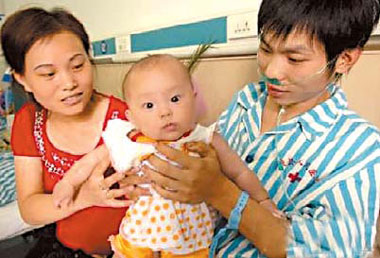Digging for daylight

An exhausted Cao Baicheng saw faint daylight coming from a hole through the sludgy water ahead. Without hesitation, he dived in and crawled forward to the light.
After pushing ahead for several meters, Cao felt a pair of hands grabbing his own, pulling him out of the water. Immediately he was blindfolded and then carried out of the dark and damp deathtrap - a flooded coalmine.
As soon as he stepped out, he heard a thundering cheer and applause.
"You are safe now. Is anyone left behind you?" said a warm voice.
"No," Cao, who was escorted to an ambulance, replied in tears. "I am the last one."
 |
|
Miners (blindfolded) were pulled out of the shaft three days after being trapped underground by floodwaters. Zhang Xiaoli |
By 12:54 pm on August 1, after 76 hours struggling underground with cold, hunger and panic, Cao and 68 other miners trapped by floodwater down in a coalmine, were all rescued.
From July 28, a heavy downpour began to hit Shanxian County in Central China's Henan Province. At 8 am on July 29, Zhang Changxing, a safety inspector of Zhijian Colliery, a State-owned coalmine operated by Zhijian Mining Co Ltd, began his round in the rain. When he stopped by Tielugou River, 100 meters from the Zhijian Colliery, he heard a tremendous crash from the west bank.
"There was a big cave-in on the west riverbed and the rushing floodwater was rapidly swirling inward," Zhang says. "I called for help immediately."
Zhang and other members from Zhijian Colliery covered the cave-in by pushing down a 5-meter high stonewall on the gap, which had a diameter of 2.5 meters. A moment later, another gap was detected and was soon blocked by big stones.
However, Zhang didn't know that the two cave-ins were actually deserted aluminum mines above the tunnel of Dongfeng No 2 Mine in Zhijian Colliery.
At the time, there were 102 miners working in the tunnel.
Before going down to the mine, miner Wang Zhengye was routinely reminded to watch for gas, which had been a major safety concern in Zhijian Colliery. As the climate is relatively dry in the area, water hazards seldom happened, and the precaution was ignored.
"Run! Flood is coming!"
At 8:40 am, while Wang was working, he heard someone shouting from the direction of the shaft, several hundred meters away from his team's working site.
 |
|
Hou Haifeng, the youngest miner rescued from the flooded mine, meets his wife and 6-month-old daughter in hospital on August 2. Zhu Xiang |
He recognized the voices as members of the transport team, who were nearest to the shaft. Wang and other scared teammates immediately ran to it.
After reaching a flat work platform used by the transport team, they found some anxious miners who had already gathered there.
"We are trapped. The exit has been submerged in water!" Several miners who tried to swim to the shaft failed, and were gasping for breath.
Suddenly, all the lights went out, with only beams of weak lights from terrified miners' headlamps shaking in the darkness. They were trapped on a 120-square-meter flat zone, 20 meters high and about 1,000 meters from the shaft.
The men fell into a restless panic - some were crying and some cursed. Cao Baicheng from the excavating team was also frightened, but he didn't forget one thing, which later proved to be the most essential lifesaving device.
Cao jumped into water and pulled out a ventilation-pipe drill. It was his digging tool which was connected to an air-storage can outside. Pulling the drill out, air could blow into the place where they were trapped. Cao had heard that asphyxia caused most deaths in flooded mines' accidents.
Meanwhile, someone also pulled out the water pipe the excavating team used. This was another crucial line for the miners, as rescuers later sent in milk and soup through the pipe.
Guo Shitun, a safety supervisor, tried to calm the miners and told them to rest. Gradually, all of the trapped miners began to cope with the their predicament.
Ji Xianfa, vice-chief of the excavating team, took a pen and a sheet of paper out of his toolbox and began to note down names of the miners on the flat. There were 69 out of a total of 102 miners - only 33 had managed to escape.
At 12 pm on July 29, a telephone ring was suddenly heard in the deathly darkness, which meant the broken telephone line was repaired.
Outside the mine, a large rescue team, about 3,000 people, including medical workers, firemen, armed police and mine experts, had been organized by the State Administration of Work Safety, provincial and local governments. The entire staff of Zhijian Colliery also joined in the rescue mission for their buddies.
The rescue team firstly repaired the telephone line.
Now clear about the situation, the rescue team came up with a plan.
It was estimated that there had been 4,000 cubic meters of water pouring into the tunnel. The most urgent task was to stop the rushing water and drain it out of the mine.
After blocking two big gaps on the riverbed, 350 armed policemen continued to cover sandbags to reinforce the riverbed and dug gutters to drain water from the river.
At 1:30 pm on July 30, three electrical pumps drained water from the mine. Rescuers removed the silts and cinders in the tunnel and tried to dig into the tunnel.
The rescue team pumped air mixed with oxygen into the ventilation pipe. To prevent oxygen poisoning and gas explosion, the air was carefully mixed.
Since most of the miners were from the excavating team, their team chiefs - Ji Xianfa, Zhu Nianqun and Cao Baicheng - were elected to lead.
Ji collected all the food and distributed it equally when most people felt hungry.
However, there were only 17 small bags of steamed buns and boiled eggs, which Ji told the rescue team.
Seven hours later, good news came: The rescue team was pumping 400 liters of milk into the water pipe, 5 centimeters in diameter. At 8 pm on July 30, everyone had a full helmet.
By August 1, the environment on the flat had became worse. Since the chamber was hermetic, the increasing carbon dioxide and miners' excretion contaminated the air.
As some miners couldn't drink milk, the rescuers sent in noodle soup. Although the rescuers were careful when removing noodles, the water pipe still got blocked.
Panic broke out among the miners. Without permission, 10 miners jumped in the water and made their way to the shaft.
"Come back, you will drown!" Ji shouted. But it was useless.
However, the miners brought good news back - they heard the voice of rescuers from outside, about 10 meters from the section they could reach.
The rescuers were making an all-out attempt to dig in. When they finally punched a hole, they heard someone shouting inside.
On the flat, Lan Jiancheng and Wang Zhengye decided to reach the hole. Ji Xianfa agreed and informed the rescue team by telephone in advance.
At 11:13 am, Lan was the first to be pulled out, followed by Wang.
The next was Ji, who led other survivors walking out of the shaft. Cao Baicheng walked behind them to keep the line.
At 12:54 pm, after Cao was taken into hospital, the 76-hour rescue was announced successful.
"This great rescue is not a coincidence," says Huang Shengchu, president of China Coal Information Institute.
"Zhijian coal mine is a low-gas mine and the roof was supported by metal brackets, therefore the water rushing in wouldn't trigger other hazards such as gas explosion and roof collapse.
"The most important thing was the three lifelines: telephone line, water pipe and ventilation pipe, which sustained the 69 lives in the three-day trap."
Li Yizhong, head of the State Administration of Work Safety, points out that the safety measures are clearly regulated in Safety Work Law. "The Chinese government has been focusing on work safety in mines, and has been investing to develop and import related technology and train more safety inspectors according to international standards," Li says.
Five days after the rescue, all 69 miners left the hospital. During their two-month recuperation, each of them receives a payment of 5,000 yuan ($660).
"I felt like I was reborn on August 1," says the 42-years-old Cao, who was officially awarded for his crucial contribution to the rescue.
"I will never forget the moment when I saw the daylight again."
(China Daily 08/16/2007 page18)














